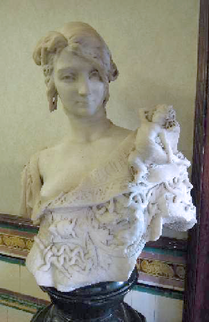Alcina
|
Research by Hilary Alcock
|
|
Artist F S Franchini Artist dates active 19th century Medium marble Size H 78.7cm (31 in), socle 31.5 cm (12.5 in) pedestal 105.4 cm (41.5 in) Date produced 1880 Inscr: 'F:S: FRANCHINI/ Roma/1880' Donor Alderman J H Dawson Date donated 26 March 1956 |
A white marble bust of Alcina by F S Franchini, dated 1880, her unkempt hair tied back and falling about her face and neck, her right breast exposed beneath an elaborate mantle, richly carved with masks and grotesques, a winged infant with cloven hooves upon her left shoulder,
titled 'Alcina' and signed and dated 'F:S: FRANCHINI/ Roma/1880'. She is displayed on a verde marble socle (supporting block/plinth), applied with a presentation tablet inscribed 'Presented by Ald J H Dawson, J.P., S.R.S.A, 26th March 1956', on an associated ebonised square fluted pedestal applied with ormolu pendants and mouldings.
Alcina is also the title of an opera seria, an Italian style opera predominate in Europe circa 1710-1770. It was composed by George Frederic Handel and set in Rome in 1728. Alcina was a magician who put her craft to good use in the art of seduction; thanks to her illusory charms, she attracts knights to her islands, whom she then transforms into wild beasts or rocks. But at last the seductress is seduced. She falls in love with the knight, Ruggiero, in whom she erases all memories of his previous life. Caught in her own trap, Alcina is doomed to decline. Ruggiero abandons her and returns to the faithful Bradamante. Deprived of her magic spells, she is left only with her tears.
Drawing on the inexhaustible wealth of stories offered by Ariosto’s “Orlando Furioso”, Handel composed “Alcina” in 1735. In this work he is at the height of his creativity, finding renewed inspiration in the enchantments experienced by this tragic heroine. The opera contains several musical sequences with opportunity for dance; these were composed for dancer and choreographer, Marie Sallé.
REFERENCE
Handel-Alcina, (2015), The Opera Platform, available online @ http://www.theoperaplatform.eu/en/opera/handel-alcina
titled 'Alcina' and signed and dated 'F:S: FRANCHINI/ Roma/1880'. She is displayed on a verde marble socle (supporting block/plinth), applied with a presentation tablet inscribed 'Presented by Ald J H Dawson, J.P., S.R.S.A, 26th March 1956', on an associated ebonised square fluted pedestal applied with ormolu pendants and mouldings.
Alcina is also the title of an opera seria, an Italian style opera predominate in Europe circa 1710-1770. It was composed by George Frederic Handel and set in Rome in 1728. Alcina was a magician who put her craft to good use in the art of seduction; thanks to her illusory charms, she attracts knights to her islands, whom she then transforms into wild beasts or rocks. But at last the seductress is seduced. She falls in love with the knight, Ruggiero, in whom she erases all memories of his previous life. Caught in her own trap, Alcina is doomed to decline. Ruggiero abandons her and returns to the faithful Bradamante. Deprived of her magic spells, she is left only with her tears.
Drawing on the inexhaustible wealth of stories offered by Ariosto’s “Orlando Furioso”, Handel composed “Alcina” in 1735. In this work he is at the height of his creativity, finding renewed inspiration in the enchantments experienced by this tragic heroine. The opera contains several musical sequences with opportunity for dance; these were composed for dancer and choreographer, Marie Sallé.
REFERENCE
Handel-Alcina, (2015), The Opera Platform, available online @ http://www.theoperaplatform.eu/en/opera/handel-alcina

